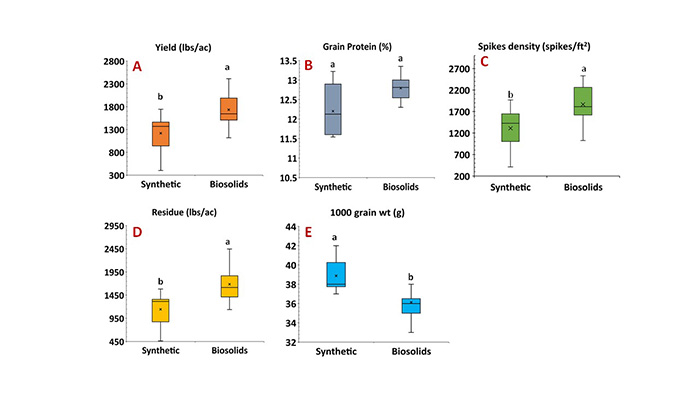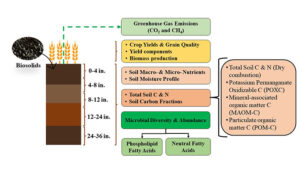Long-term agronomic impacts in dryland wheat systems
Wheat production in the dryland region of the Inland Pacific Northwest (PNW) is strongly reliant on limited rainfall and soil moisture availability. This dryland region of Eastern Washington receives less than 14 inches of rainfall annually, and soils in the region are characterized by erosion-prone and low soil organic carbon (SOC) content. The wheat-fallow system is the most common cropping system in this region and typically involves tillage during spring of the fallow period to minimize soil water evaporative loss during the hot, dry summer. While this rotation results in reliable wheat yields, it is associated with decline in SOC, increased wind erosion, and overall degradation of soil health, which are among a few major increasing concerns among farmers in the region. The reduction in SOC, in turn, contributes to decreased nutrient cycling, water retention, and overall soil fertility. To help improve soil health, farmers and researchers are looking into the feasibility and economics of adding amendments like biosolids, biochar, and manure, mainly because limited low moisture availability limits how much crop biomass can be produced and added to soils. Additionally, conservation tillage (e.g., undercutter tillage, no-tillage, etc.) and crop residue retention can help in improving SOC, nutrient availability, soil health, and reduce erosion.
In response to these challenges, researchers in the region have been investigating cost-effective strategies to improve SOC and enhance sustainability. One potential alternative that is getting traction is the incorporation of biosolid fertilizers into soils. Biosolids, produced as by-products of municipal wastewater treatment, are processed and tested to meet U.S. Environmental Protection Agency standards. Studies across the U.S. showed that using biosolids is an effective way to improve soil fertility, SOC, soil water retention, nutrient availability, and microbial activity and abundance while reducing soil erosion and compaction, especially in dryland wheat systems. While immediate benefits when actively applying biosolids have been researched in the region to some extent, there is still a lack of research-based information on the persistence and residual effects of biosolids applications (after discontinuation of applications), hereafter referred as “legacy effects” in the low precipitation region of the PNW.
We conducted a study to determine the legacy effects of biosolids seven years after the last application at the Washington State University’s Lind Dryland Research Station. The study was set up in 2012 under a wheat-fallow system with two fertilizer treatments including biosolids and synthetic fertilizers (N+S fertilizers) and two tillage treatments including
traditional tandem disk and conservation undercutter tillage. Both tillage treatments were applied immediately after biosolids applications at 2.8 dry tons per acre (on dry weight basis to meet two wheat crops requirements) in mid-April of 2012 and 2016. Anaerobically digested and dewatered Class B biosolids were sourced from the King County wastewater treatment plant. For synthetic fertilizer treatment, 50 pounds of nitrogen per acre and 10 pounds of sulfur per acre were applied for each wheat crop as liquid aqua NH3-N and thiosol S, respectively. Synthetic fertilizers were injected with the undercutter in late April. For the tandem disk treatment, synthetic N+S was stream-jetted on the surface then immediately incorporated into the soil. These treatments were continued until 2019, and![]() after that, all the plots were tilled, fertilized with synthetic fertilizer (N+S), and returned into wheat-fallow rotation. In 2022, to determine the legacy effects of previous biosolids application on yields, soft white winter wheat was seeded in late August 2022.
after that, all the plots were tilled, fertilized with synthetic fertilizer (N+S), and returned into wheat-fallow rotation. In 2022, to determine the legacy effects of previous biosolids application on yields, soft white winter wheat was seeded in late August 2022.
Soil samples were taken from the top 4 inches of soil and tested for pH, electrical conductivity, nitrate-N, ammonium-N, phosphorus, potassium, calcium, magnesium, sodium, sulphur, zinc, iron, manganese, copper, boron, total soil carbon, and total soil nitrogen. (Table 1). Grain yields, spike density, thousand kernel weight, and straw production (biomass without grain) were measured from each plot, as well as grain protein. Results showed that seven years after the last application of biosolids, soil nutrients were significantly higher
compared to synthetic fertilizer. As you can see in Table 1, measured amounts of soil nutrients ranged from 1.6 times higher for both sulfur and iron, 1.8-fold for manganese, 2.3 times higher for copper, 3.2 times higher for phosphorus, and up to 6.1-fold for zinc in the biosolids treatments. Total soil carbon and nitrogen were higher under biosolids with undercutter tillage than the disk with synthetic fertilizer.

The biosolids’ legacy effects were also more pronounced on crop responses, including spike density, grain yield, and straw production that were up to 47% higher (Figure 2). Although previous studies reported higher grain protein under biosolids, the legacy effects of biosolids and synthetic fertilizers showed similar grain protein. The increased straw production under biosolids can be crucial for the low SOC, erosion-prone soils of the PNW. The long-term availability of soil nutrients from biosolids’ legacy is likely why grain yield (42%), straw production (47%), and spike density (42%) were higher compared to synthetic fertilizer. Our study shows that even seven years after the last application, biosolids continue to supply both macro- and micro-nutrients, making them a cost-effective and long-lasting option for boosting soil nutrient availability in the PNW drylands. Overall, biosolids improved nutrient availability, wheat grain yield, and some yield components even seven years after the last application. This study suggests that periodic biosolids application can enhance soil nutrient availability, SOC, and grain yields in dryland wheat systems of PNW.
Ongoing research at Lind Dryland Research Station

Currently, I (Surendra Singh) Dr. Shikha Singh at the Lind Dryland Research Station to continue tracking more detailed legacy effects of biosolids applications in dryland wheat systems such as SOC sequestration, greenhouse gas emissions, deep soil carbon, nutrient supply, microbial diversity and abundance, microbial activity, carbon fractions, and overall soil health (Figure 3).
For more information related to this article please refer to these articles and podcast:
- Wheat Beat Podcast with Drew Lyon, “Digging into the Legacy in Dryland Research with Dr. Surendra Singh” (Nov. 4, 2024). Link: https://smallgrains.wsu.edu/wbp195/
- Schillinger, W. F., Cogger, C. G., & Bary, A. I. (2022), “Biosolids and conservation tillage for rainfed wheat farming in dry Mediterranean climates.” Soil and Tillage Research, 223, 105478. Link: https://www.sciencedirect.com/science/article/abs/pii/S0167198722001647
- Singh, S., Singh, S., Schillinger, B., Griffin-LaHue, D., & Neely, H., “Biosolids in the Dryland Pacific Northwest Seven Years After Application: Wheat Yields, Soil Carbon, and Nutrient Availability Continue to Be Enhanced.” Crops & Soils. 57, 50-55. Link: https://doi.org/10.1002/crso.20407
This article originally appeared in the January 2025 issue of Wheat Life Magazine.
Authors:
References:
Cogger, C. G., Bary, A. I., Kennedy, A. C., & Fortuna, A.M. (2013a), “Long-term crop and soil response to biosolids applications in dryland wheat,” Journal of Environmental
Quality, 42(6), 1872–1880. https://doi.org/10.2134/jeq2013.05.0109
Pi, H., Sharratt, B., Schillinger, W.F., Bary, A. I., & Cogger, C. G. (2018), “Wind erosion potential of a winter wheat–summer fallow rotation after land application of biosolids,”
Aeolian Research, 32, 53-59
